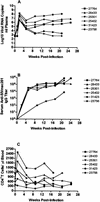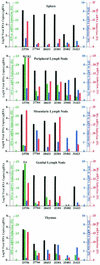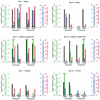The relationship between simian immunodeficiency virus RNA levels and the mRNA levels of alpha/beta interferons (IFN-alpha/beta) and IFN-alpha/beta-inducible Mx in lymphoid tissues of rhesus macaques during acute and chronic infection
- PMID: 12134046
- PMCID: PMC155165
- DOI: 10.1128/jvi.76.16.8433-8445.2002
The relationship between simian immunodeficiency virus RNA levels and the mRNA levels of alpha/beta interferons (IFN-alpha/beta) and IFN-alpha/beta-inducible Mx in lymphoid tissues of rhesus macaques during acute and chronic infection
Abstract
To define the role of alpha/beta interferons (IFN-alpha/beta) in simian immunodeficiency virus (SIV) infection, IFN-alpha and IFN-beta mRNA levels and mRNA levels of Mx, an antiviral effector molecule, were determined in lymphoid tissues of rhesus macaques infected with pathogenic SIV. IFN-alpha/beta responses were induced during the acute phase and persisted in various lymphoid tissues throughout the chronic phase of infection. IFN-alpha/beta responses were most consistent in tissues with high viral RNA levels; thus, IFN-alpha/beta responses were not generally associated with effective control of SIV replication. IFN-alpha/beta responses were differentially regulated in different lymphoid tissues and at different stages of infection. The most consistent IFN-alpha/beta responses in acute and chronic SIV infection were observed in peripheral lymph nodes. In the spleen, only a transient increase in IFN-alpha/beta mRNA levels during acute SIV infection was observed. Further, IFN-alpha and IFN-beta mRNA levels showed a tissue-specific expression pattern during the chronic, but not the acute, phase of infection. In the acute phase of infection, SIV RNA levels in lymphoid tissues of rhesus macaques correlated with mRNA levels of both IFN-alpha and IFN-beta, whereas during chronic SIV infection only increased IFN-alpha mRNA levels correlated with the level of virus replication in the same tissues. In lymphoid tissues of all SIV-infected monkeys, higher viral RNA levels were associated with increased Mx mRNA levels. We found no evidence that monkeys with increased Mx mRNA levels in lymphoid tissues had enhanced control of virus replication. In fact, Mx mRNA levels were associated with high viral RNA levels in lymphoid tissues of chronically infected animals.
Figures





Similar articles
-
Reduced Chronic Lymphocyte Activation following Interferon Alpha Blockade during the Acute Phase of Simian Immunodeficiency Virus Infection in Rhesus Macaques.J Virol. 2018 Apr 13;92(9):e01760-17. doi: 10.1128/JVI.01760-17. Print 2018 May 1. J Virol. 2018. PMID: 29467313 Free PMC article.
-
Gamma interferon-mediated inflammation is associated with lack of protection from intravaginal simian immunodeficiency virus SIVmac239 challenge in simian-human immunodeficiency virus 89.6-immunized rhesus macaques.J Virol. 2004 Jan;78(2):841-54. doi: 10.1128/jvi.78.2.841-854.2004. J Virol. 2004. PMID: 14694116 Free PMC article.
-
High beta-chemokine expression levels in lymphoid tissues of simian/human immunodeficiency virus 89.6-vaccinated rhesus macaques are associated with uncontrolled replication of simian immunodeficiency virus challenge inoculum.J Virol. 2004 Jun;78(12):6399-408. doi: 10.1128/JVI.78.12.6399-6408.2004. J Virol. 2004. PMID: 15163733 Free PMC article.
-
Localization of Simian immunodeficiency virus-infected cells in the genital tract of male and female Rhesus macaques.J Reprod Immunol. 1998 Dec;41(1-2):331-9. doi: 10.1016/s0165-0378(98)00069-2. J Reprod Immunol. 1998. PMID: 10213321 Review.
-
Unique lentivirus--host interactions: SIVsmmPBj14 infection of macaques.Virus Res. 1994 May;32(2):205-25. doi: 10.1016/0168-1702(94)90042-6. Virus Res. 1994. PMID: 8067054 Review.
Cited by
-
In captive rhesus macaques, cervicovaginal inflammation is common but not associated with the stable polymicrobial microbiome.PLoS One. 2012;7(12):e52992. doi: 10.1371/journal.pone.0052992. Epub 2012 Dec 28. PLoS One. 2012. PMID: 23285244 Free PMC article.
-
Identification of miRNA-mRNA crosstalk in CD4+ T cells during HIV-1 infection by integrating transcriptome analyses.J Transl Med. 2017 Feb 21;15(1):41. doi: 10.1186/s12967-017-1130-y. J Transl Med. 2017. PMID: 28222782 Free PMC article.
-
Type I interferon responses in rhesus macaques prevent SIV infection and slow disease progression.Nature. 2014 Jul 31;511(7511):601-5. doi: 10.1038/nature13554. Epub 2014 Jul 9. Nature. 2014. PMID: 25043006 Free PMC article.
-
Simian immunodeficiency virus interactions with macaque dendritic cells.Adv Exp Med Biol. 2013;762:155-81. doi: 10.1007/978-1-4614-4433-6_6. Adv Exp Med Biol. 2013. PMID: 22975875 Free PMC article. Review.
-
SIV infection of rhesus macaques differentially impacts mononuclear phagocyte responses to virus-derived TLR agonists.J Med Primatol. 2013 Oct;42(5):247-53. doi: 10.1111/jmp.12064. Epub 2013 Jul 30. J Med Primatol. 2013. PMID: 23905748 Free PMC article.
References
-
- Abb, J., M. Kochen, and F. Deinhardt. 1984. Interferon production in male homosexuals with the acquired immune deficiency syndrome (AIDS) or generalized lymphadenopathy. Infection 12:240-242. - PubMed
-
- Abel, K., M. J. Alegria-Hartman, K. Zanotto, M. B. McChesney, M. L. Marthas, and C. J. Miller. 2001. Anatomic site and immune function correlate with relative cytokine mRNA expression levels in lymphoid tissues of normal rhesus macaques. Cytokine 16:191-204. - PubMed
-
- Abrams, M. E., M. J. Balish, and C. R. Brandt. 1995. IFN-alpha induces MxA gene expression in cultured human corneal fibroblasts. Exp. Eye Res. 60:137-142. - PubMed
-
- Antonelli, G., E. Simeoni, O. Turriziani, R. Tesoro, A. Redaelli, L. Roffi, L. Antonelli, M. Pistello, and F. Dianzani. 1999. Correlation of interferon-induced expression of MxA mRNA in peripheral blood mononuclear cells with the response of patients with chronic active hepatitis C to IFN-alpha therapy. J. Interferon Cytokine Res. 19:243-251. - PubMed
-
- Asselin-Paturel, C., A. Boonstra, M. Dalod, I. Durand, N. Yessaad, C. Dezutter-Dambuyant, A. Vicari, A. O'Garra, C. Biron, F. Briere, and G. Trinchieri. 2001. Mouse type I IFN-producing cells are immature APCs with plasmacytoid morphology. Nat. Immunol. 2:1144-1150. - PubMed
Publication types
MeSH terms
Substances
Grants and funding
LinkOut - more resources
Full Text Sources

